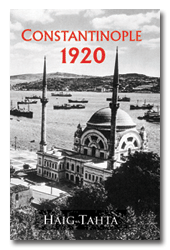Constantinople 1920, the second book in Haig Tahta’s projected trilogy, chronicles the impending fall of the Ottomans and explores the circumstances and atmosphere of Constantinople during the British occupation of the city from 1920 to 1922. It carries forward the same characters from Mr. Tahta’s first novel, April 1915, set in the Ottoman Empire at a critical moment following its fateful decision to join the Great War in November 1914. Olga,
an Armenian girl, and Selim, a Turk, are impossibly in love.
Their relationship, much more difficult and problematic than
Romeo and Juliet, develops and unfolds during the Greco-Turkish
War, reaching its shocking climax in the burning of Smyrna.
An historical novel of deep insight and high passions, Constantinople
1920 brings to focus a time which echoed throughout the world
and set in train events that would engulf Europe in flames
a few decades later. Written with a rare sense of humanity
and peopled with a plethora of characters, bold, sensitive,
articulate and always fascinating, Constantinople 1920 is
that rare novel of ideas and drama that appeals to both the
heart and the intellect. |
CONSTANTINOPLE
1920 ISBN: 9781900355582
Choose your currency UK Sterling US Dollars Euros |

